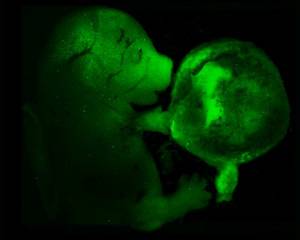Mature tissues can be re-programmed in-situ to produce stem cells, scientists have shown for the first time.
The concept of re-programming  adult cells to switch them from a specialised state to an unspecialised iPS - induced pluripotent - "stem cell" state is well known.
adult cells to switch them from a specialised state to an unspecialised iPS - induced pluripotent - "stem cell" state is well known.
But this manipulation, which involves adding four signalling factors to the cells, has heretofore been carried out in a laboratory dish and with relatively low efficiency.
Now, Manuel Serrano, from the Spanish National Cancer Research Centre in Madrid, and his colleagues have shown that it's also possible to reprogramme cells within mature tissues inside the body without resorting to a Petri dish.
The approach taken by the Spanish team, published this week in Nature, was to first make genetically modified mice into which the genes encoding the four reprogramming chemicals (called c-Myc, Klf4, Oct4 and Sox2) had been inserted under the control of a genetic switch that could be temporarily turned on by administering a dose of an antibiotic drug to the animals.
Administering the drug to the adult mice resulted in growths, in multiple tissues, called teratomas. These are a hallmark of pluripotent cells being formed.
The team were also also to extract from the blood of the animals circulating stem cells resulting from the process; injected into early mouse embryos, these stem cells were able to turn into any tissue in the developing mouse body, proving that they were genuinely unspecialised stem cells.
Interestingly, the cells appeared to be superior in this regard to their counterparts made the traditional way in a dish, suggesting that the three-dimensional nature of the environment in which they formed within organs in some way improves the re-programming efficiency.
Specifically, the cells were capable of giving rise to a broader range of embryonic tissues than traditional iPS cells or even embryonic (ES) stem cells.
These remarkable findings suggest that it may be possible in future to repair organs by triggering the re-programming of a small number of cells locally so they become stem cells that can then be guided, chemically, to reconstruct the tissues damaged by a disease.










Comments
Add a comment